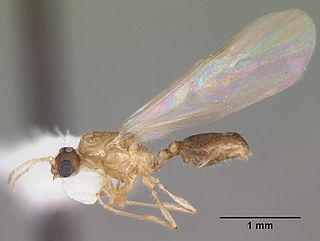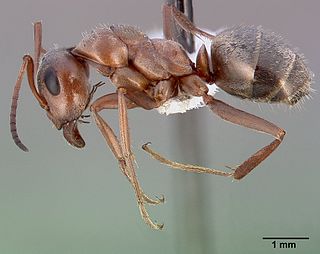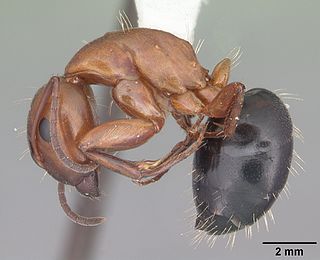Myrmecina alpina is a species of ant in the family Formicidae.
Myrmecina difficulta is a species of ant in the family Formicidae.
Myrmecina eruga is a species of ant in the family Formicidae.
Myrmecina inaequala is a species of ant in the family Formicidae.
Myrmecina pumila is a species of ant in the family Formicidae.
Myrmecina silvalaeva is a species of ant in the family Formicidae.
Myrmecina silvangula is a species of ant in the family Formicidae.
Myrmecina silvarugosa is a species of ant in the family Formicidae.
Myrmecina silvatransversa is a species of ant in the family Formicidae.

Myrmecina is a genus of ants in the subfamily Myrmicinae. It contains 53 species distributed in North America, Europe, northern Africa, India east, Korea, Japan and Australia.

Formica gagatoides is a species of ant in the family Formicidae. It is found in Europe.

Camponotus vicinus is a species of ant in the subfamily formicinae. C. vicinus is widespread throughout western North America, from Alaska, south to Mexico, and east to Texas and Manitoba. Unlike its wood nesting "carpenter ant" relatives, Camponotus vicinus is typically found nesting in the soil under stones and other objects. The giant ants in the 1954 film Them! are identified as C. vicinus, despite multiple anatomical differences, including the presence of a sting, which is absent in Formicine ants.

Solenopsis carolinensis, the thief ant, is a species of ant in the family Formicidae.

Formica aerata, the grey field ant, is a species of ant in the family Formicidae.

Camponotus decipiens is a species of ant in the family Formicidae.

Pogonomyrmex desertorum, the large seed harvesting ant, is a species of ant in the family Formicidae.

Gnamptogenys hartmani is a species of ant in the family Formicidae.

Pseudomyrmex seminole is a species of ant in the family Formicidae.

Myrmecina graminicola is a species of ant found throughout Northern Africa, Europe, Asia, and elsewhere in the Palearctic realm. Its colonies build nests in soil, under rocks, and in leaf litter. It was described in 1802 by Pierre André Latreille, initially in the genus Formica. They are not an aggressive species. When a worker encounters an intruder, it starts to play dead with its legs and antennae folded. They live in colonies that have less than 100 workers and one queen. Before mating, the female ant releases a pheromone that the male ant is attracted to this and the mating then occurs seconds after. The ant colonies move around following the queen's pheromone trail.











